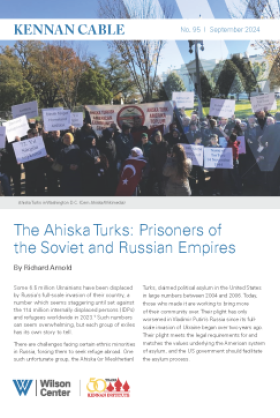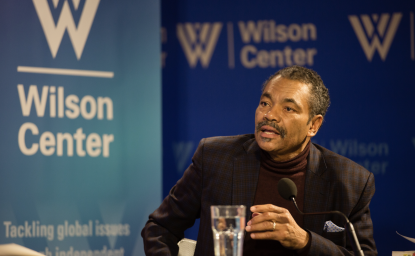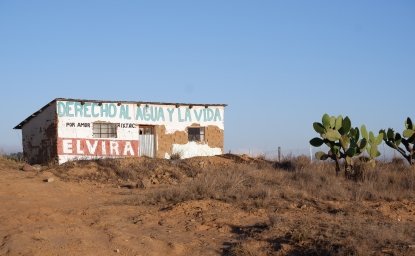Kennan Cable No. 95: The Ahiska Turks: Prisoners of the Soviet and Russian Empires



Some 6.5 million Ukrainians have been displaced by Russia’s full-scale invasion of their country, a number which seems staggering until set against the 114 million internally displaced persons (IDPs) and refugees worldwide in 2023.[1] Such numbers can seem overwhelming, but each group of exiles has its own story to tell.
There are challenges facing certain ethnic minorities in Russia, forcing them to seek refuge abroad. One such unfortunate group, the Ahiska (or Meskhetian) Turks, claimed political asylum in the United States in large numbers between 2004 and 2006. Today, those who made it are working to bring more of their community over. Their plight has only worsened in Vladimir Putin’s Russia since its full-scale invasion of Ukraine began over two years ago. Their plight meets the legal requirements for and matches the values underlying the American system of asylum, and the US government should facilitate the asylum process.
Tortured Past
Russian and Soviet history is replete with examples of ethnic and religious repression. Yet even among such misery, the Ahiska story stands out. The group lived in present-day Georgia during the Ottoman Empire. Centuries later, the end of the Russian Civil War saw their ancestral lands incorporated into the new Union of Soviet Socialist Republics (USSR). Unlike many other ethnic minorities in the Soviet Union, the Ahiska Turk identity was not institutionally recognized at the territorial level in the 1920s.[2] There is no “Ahiska Turk” ethnic republic, oblast, krai, or even administrative district. In the name of quickly assimilating large ethnic groups into socialism, Soviet policies in the 1920s and 1930s created regions protecting eponymous groups and promoting their cultures and languages within those territories.[3] The two largest (and hence most notable) exceptions were the Ahiska Turks and the Crimean Tatars. Without an eponymous region, neither group belonged anywhere in the Soviet Union, making both vulnerable to decades of political predation.
In 1944, possibly in preparation for a Soviet offensive into Turkey, Joseph Stalin branded the Ahiska “enemies of the people” and deported them to Uzbekistan. (Others, like the Chechens, Crimean Tatars, Volga Germans, and Ingush, were similarly judged to be disloyal and deported.[4]) In the course of the deportation of the Ahiska, 92,307 people were forced onto cattle trains. Stalin sent 30,000 Ahiska soldiers already serving in the Soviet army to guard them, making these soldiers complicit in the deportation of their own people. The conditions of the deportation were deplorable: people were moved by trucks and cattle trains in the depth of winter with insufficient food, rampant disease, and lice infestations. Thousands perished, although the true number of fatalities is unknown.
Stalin’s death in 1953 made it possible for many exiled communities to return to their native lands. However, for reasons of military preparedness and the inner workings of the Soviet Union, Nikita Khruschev did not rehabilitate the Ahiska Turks, Volga Germans, or the Crimean Tatars, forcing them to remain in exile. Officials from the Georgian SSR, especially in the Khruschev and Brezhnev periods, were given considerable latitude in running Georgian internal affairs and fiercely resisted having a Muslim Turkish community return to their ancestral lands in Meskhetii, which it viewed as the central location of the Georgian nation. Activists from the Ahiska rights group Vatan (“Homeland”) went to the Central Committee of the USSR in 1968 to lobby the issue but were rebuffed.[5]
“Complicating the lives of this community is the fact that the Ahiskan dialect (an Eastern Anatolian version of standard Turkish with words from other languages incorporated, reflecting their experiences of deportation) makes it difficult for regular Turkish speakers to understand them. They remained in Uzbekistan for decades, where they were targets of discrimination from local citizens and state institutions alike.
In 1989, that discrimination led to outright pogroms against the Ahiska in Uzbekistan. In June alone, some 52 Ahiska Turks died in the attacks.[6] Rioters set fire to homes where the Ahiska lived and beat individuals and small groups of Ahiska in the streets. Human rights scholar Alexander Osipov wrote about the possibility that the KGB arranged the pogroms to show the Uzbek authorities that the locals could not cope with interethnic strife.[7] The Soviet army eventually evacuated the Ahiska and resettled them in various parts of the Soviet Union, including Russia, Ukraine, Kazakhstan, and Azerbaijan. This second forced resettlement involved dispersal and a persistent Georgian refusal to facilitate their return.
Following the pogroms mentioned above, some Turks did return to Georgia, but the authorities, led by Zviad Gamsakhurdia, forced a lot of them out. Those who did remain were forced to adopt Georgian family names and profess Georgian ancestry. Even resettled, Ahiska were still far from safe. Fighting in Nagorno-Karabakh in the early 1990s led to another deportation for Ahiska placed there.[8] Others went to Southern Russia, where they lived in the regions of Belgorod, Kabardino-Balkaria, Kalmykia, Krasnodar, Rostov, and Stavropol.[9] While many continued to face outright discrimination in the provision of public goods, discrimination continued its starkest form in Krasnodar Krai.[10]
The Post-Soviet Period
During the 1990s, the regional authorities in Krasnodar refused to recognize the presence of the Ahiska Turks or to give them a propiska, the residency permit by which the Soviet Union controlled where individuals and ethnic groups could settle and live. While the Russian supreme court declared the propiska system illegal in 1992, according to human rights scholar Steve Swerdlow, regional authorities continued to use it “in open defiance of federal law.”[11] Without propiskas, the Ahiska could not receive Russian passports, and consequently many continued to use their Soviet passports well into the 1990s and early 2000s. Worse, Cossack paramilitary forces recruited by the local authorities as a volunteer militia to enforce regional nationalism periodically attacked the Ahiska. Cossacks attacked on at least 21 separate documented occasions between 1991 and 2006, although the true number is assuredly higher.[12]
The two governors of the Krasnodar region, Nikolai Kondratenko (1995–2001) and Aleksandr Tkachyov (2001–2015), mistreated the Ahiska in similar ways, though the latter was arguably the more zealous. The regional government’s monopoly on the media, even in the 1990s and 2000s, enabled elites to disseminate wild accusations bordering on blood libel. For example, accusations ranged from the economic (stealing Russian jobs, evading taxes) to the criminal (raping Russian boys, dealing in drugs) and the political (spying for the United States).[13] Whatever the rationale, the end result was the same: the othering and defamation of the Ahiska population.
Finally, between 2004 and 2006 the Ahiska gained some sort of legal protection. Under the auspices of the International Organization for Migration (IOM) and the US Department of State, US authorities gave asylum to roughly half the Ahiska (10,000 to 15,000) in Krasnodar. Initially, this meant resettlement to Washington DC, Lancaster, PA, and Phoenix, AZ. Over time, however, the largest concentration of Ahiska in the United States emerged around Dayton, OH, where the Ahiska have their own community center. Fortunate Ahiska individuals now lead new lives in the United States, escaping over 75 years of repressive state policy and periodic pogroms.
Logical alternatives to US asylum proved, and continue to prove, unwilling to provide this troubled group a home. Authorities in their original homeland, former Ottoman lands now governed by the Republic of Georgia, do not want them back—at least, not as Ahiska Turks. In 2003, the Georgian government officially acknowledged its obligation to take Ahiska refugees, but since then it has done little to accommodate them. The Georgian government already confronts ethnic problems and is unwilling to add another. According to scholar Aysegul Aydingun, it fears that the Ahiska Turks could develop into a fifth column and bring about “the next Nagorno-Karabakh.”[14] The Georgian implied solution—that the Ahiska surrender their Turkish identity in favor of a Georgian one—is not acceptable to the Ahiska. Next door, the Turkish government’s policy is to encourage Turks outside of Turkey to remain where they are, even if they have co-ethnic sympathies with the Ahiska.[15]
After 2006, some 75,000 Ahiska individuals remained inside Russia (28,500 in Rostov, 7,500 in Stavropol, 5,425 in Krasnodar, 4,000 in Voronezh, and in other Russian regions).[16] Ethnic discrimination on both the societal and state level continues against them. In most cases, this has meant difficulty in obtaining public goods like education and medical care, for which they have had to pay increased bribes. But it has also meant the 2012 murder of a 19-year old Ahiska Turk in Rostov Oblast and the disruption of an Ahiska wedding in Kabardino-Balkaria in 2013. Abuses previously concentrated in Krasnodar Krai have spread to other regions like Stavropol and Rostov.[17]
Dangerous Present
The Russian government’s mistreatment of the Ahiska reached new heights during the prosecution of its war in Ukraine. This has taken two principal forms- dragooning Ahiska men into the military and ravaging their lands.
First, Russian authorities disproportionately target young Ahiska men for mobilization into the army. Practically every male under the age of 50 of Ahiska heritage is a target of the recruiting squads on the streets in Rostov and served with a draft notice. Most of the Ahiska males of fighting age that I have testified for in asylum trials have actual copies of their draft notices and instructions to report to recruitment centers. The Russian way of war results in disproportionate deaths among minorities, even those with official or territorial status.[18] The Ahiska are expendable, as Russian society will not notice their deaths.
And it is not just men who fear the front line. One young woman who trained as a nurse feared being sent to frontline hospitals, as her skills are needed in the senseless war. According to asylum statements I have reviewed, those with auxiliary war roles (such as truck drivers, railroad operators, munitions factory workers, and the like) are also disproportionately ethnic minorities. The liminal status of the Ahiska in Russian society makes their deployment in such dangerous theaters low-cost for the Russian state.
Second, many of the Ahiska in both Russia and Ukraine live in the very areas where the war is. As of 2022, numerous Ahiska lived in Belgorod, Kursk, and Rostov Oblasts, regions of Russia abutting Ukraine. Even if not called up to fight or brought forward to the frontline hospitals, those simply living and working in these areas risk death.
Of course, there are many instances of regular discrimination. From the typical post-Soviet practice of economic raiding that robbed Ahiska proprietors of their successful cafés, to more routine examples of discrimination in housing and education (Ahiska children in the past 10 years have received lower grades for superior work simply because they were “non-Russians”), discrimination against the Ahiska is rife. The list of rights violations is long.
Meanwhile, those Ahiska who were relocated to Ukraine after 1989 are stranded in the very lands now being invaded. A Change.org petition from February 2022 identifies 1,500 Ahiska families living in the Kherson region, 280 in Mykolaiv, 250 in the Odessa region, 150 in the Kharkiv region, and 50, respectively, in Donetsk and Sumy.[19] The petition claims to represent 11,000 people in total. There is little data on the Ukrainian government’s treatment of the Ahiska prior to the full-scale invasion, which makes me think that discrimination was either less than in Russia or non-existent.
The fact that the Ahiska lived in places either partly or wholly occupied by Russia now means there is no safe space in Ukraine to which they can return. Russia is drafting the Ahiska at high rates, so Ahiska serving in the Ukrainian armed forces may have to shoot at kin mobilized in Russia—although this situation is not unique to the Ahiska.
Ominous Future
The Ahiska face threats in Russia away from the war as well. Radical Islamists from the group ISIS-K attacked a concert at Crocus City Hall outside Moscow, on March 22, 2024, killing at least 137. A few months later, Islamic terrorists opened fire at synagogues and churches in Dagestan, killing 15 police officers.[20] Russian citizens fear their country is in for a sustained terrorist campaign. Based on how Russian security agencies profiled religious communities after the Beslan and Nord-Ost terrorist attacks, the Muslim Ahiska Turks are at risk, especially considering that they are stateless in Russia’s mosaic of interlocking ethnoterritorial units. Vigilantes may target other religious minorities like Tajiks, but at least they have a country in which they are safe and legally entitled to stay. The Ahiskas’ ambiguous legal status affords them no such protection.
Russian mainstream society has been traumatized by terror attacks before and is conditioned to react against outsiders suspected of sympathy for terrorists or even of providing for terrorist recruits. Hate crimes in Russia seem to be rising, particularly against migrants. Russia’s Cossack movement (which is now providing 50,000 fighters for the war in Ukraine) also shows signs of ethnic hostility.[21] Given the prominent role of the Kuban Cossacks in driving the Ahiska from settlements in Krasnodar, and the rise of former Kuban Ataman Nikolai Doluda to a leadership role with the national movement of Cossack societies, Ahiska Turks are likely on the list of targets.[22] The Ahiska are victims not just of mobilization and death on the front, but also paranoia from government-stoked fears at home and newly deputized vigilantes.
History shows that totalitarian regimes, such as Putin’s Russia, tend to turn inward in their search for enemies. In the Soviet Union, the state targeted the Kulaks, the Jews, and other “politically unreliable” groups. Any loss in the war in Ukraine could well spark a search for scapegoats, for which the Ahiska are almost ideally situated. Russian internal recriminations resulting from a failed invasion, a scenario in which the Ahiska would find themselves without an institutional champion, would be calamitous for them. As Russian history has demonstrated time and again, it is the weakest in society who bear the brunt of hardship and repression. The marginal status of the Ahiska and their previous discrimination makes them especially vulnerable.
Conclusion
The Ahiska Turks are just one minority in multiethnic and multi-confessional Russia, and certainly not the largest. However, their tortured past, their dangerous present, and their ominous future makes them one of the most persecuted in history. They endured deportation in 1944, pogroms in Uzbekistan in 1989, and Cossack attacks in Krasnodar in the 1990s and throughout the North Caucasus today. Americans can be proud of offering approximately 10,000 Ahiska political asylum 20 years ago.
Once again, the need is great for the Ahiska left behind in Russia, where they confront a hostile government ready to send them to the front and suspicious neighbors who believe they harbor potential terrorists. Mediazona estimates that 120,000 Russian troops have already died, and the total number of those killed or severely wounded in the war in Ukraine exceeds 500,000.[23] Legally, avoiding conscription is sufficient grounds for asylum when a war has been condemned by the international community, as this war has been. The Ahiska also have credible fear of attack from elements of Russian extremists. Part of the reason Russian society is not protesting the war is that the most vulnerable, like the Ahiska, are the ones dying. The United States has a moral and practical obligation to ease the path to asylum for members of this group. Politically, too, such a policy may drive a wedge between Russia and Turkey as well as embarrassing the pro-Russian Georgian government for its continued refusal to facilitate the resettlement of the Ahiska in line with obligations accepted in 1999 in preparation for admission to the Council of Europe. Once again, the United States can demonstrate that it not only proclaims its values but lives by them as well.
[1] Mark Green, “Numbers in Motion, Children in Motion,” Stubborn Things (blog), Wilson Center, April 23, 2024.
[2] Yuri Slezkine, “The USSR as a Communal Apartment, or How a Socialist State Promoted Ethnic Particularism” Slavic Review 53, no. 2 (1994): 414–452; and Terry Martin, The Affirmative Action Empire: Nations and Nationalism in the Soviet Union, 1923–39 (Ithaca, NY: Cornell University Press, 2001).
[3] Slezkine, 430
[4] Gokut Kiprizili, “Victims of the Soviet Policies: The Case of the Ahiska Turks (1944–1968),” Avrasiya Etudlieri 56, no. 2 (2019): 79–98.
[5] Steve Swerdlow, “Understanding Post-Soviet Ethnic Discrimination and the Effective Use of US Refugee Resettlement: The Case of the Meskhetian Turks of Krasnodar Krai,” California Law Review 94 (2006): 1827–1828, 1838; and emails with Steve Swerdlow, August 22, 2024.
[6] Александр Осипов, Ферганские события: конструирование этнического конфликта (Москва, Наука, 2004), 179.
[7] Осипов, 179.
[8] Осипов, 180.
[9] Richard Arnold, Russian Nationalism and Ethnic Conflict: Symbolic Violence, Lynching, Pogrom, and Massacre (New York: Routledge, 2016); Matthew Light. Fragile Migration Rights, freedom of movement in post-Soviet Russia (New York, Routledge, 2016).
[10] Swerdlow.
[11] Swerdlow, “Understanding,” 1841.
[12],Richard Arnold, 85-107.
[13] Parikama Gupta, “De facto Stateless: The Meskhetian Turks,” Central Asia and the Caucasus 5, no. 41 (2006): 126–138, 132.
[14] Aysegul Aydingun, “Ahiska (Meskhetian) Turks: The Next Source of Conflict in the Caucasus?” International Journal of Human Rights 6, no. 2 (2002): 49–64, 53.
[15] Gupta, 133–34.
[16] Robert Cobb, “Meskhetian Turks: Ten Years On,” Eurasian Daily Monitor, November 27, 2014.
[17] Elena Vlasenko, “Nobody Wants Russia’s Turks,” OpenDemocracy, February 26, 2014, https://www.opendemocracy.net/en/odr/nobody-wants-russias-turks/
[18] Maria Vyushkova, “Buryatia and the High Toll of Russia’s War in Ukraine on Ethnic Minorities,” The Russia File (podcast), Wilson Center, January 24, 2024.
[19] Ahiska Turkish-American Council, “Together We Stop War,” petition on Change.org (website), February 26, 2022.
[20] Kathleen Magramo and Jerome Taylor, “Dagestan and Moscow: Russia Has Seen Two Terror Attacks in Just Three Months. Here’s What We Know,” CNN, June 24, 2024.
[21] Richard Arnold, “Moscow Uses Cossacks to Feign Interethnic Harmony in Russia,” Eurasia Daily Monitor, June 26, 2024.
[22] Kuban is the name of the river in Krasnodar Krai and the Cossacks have revived the imperial habit of using geographical, rather than administrative, names
[23] Mediazone (website), “Russian Losses in the War with Ukraine. Mediazona Count, Updated,” accessed August 15, 2024.


The Kennan Institute is the premier US center for advanced research on Eurasia and the oldest and largest regional program at the Woodrow Wilson International Center for Scholars. The Kennan Institute is committed to improving American understanding of Russia, Ukraine, Central Asia, the South Caucasus, and the surrounding region through research and exchange. Read more


